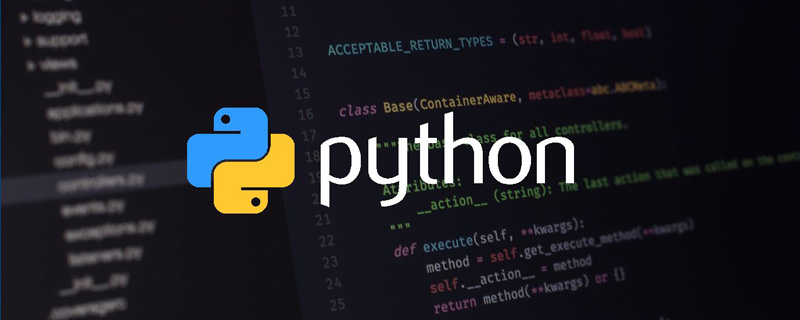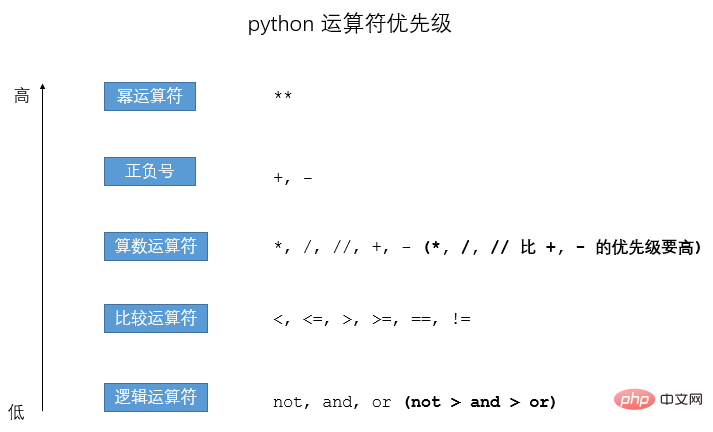What are the commonly used operators in Python?
Like most other languages, commonly used operators in python also include arithmetic operators, comparison operators, and logical operators, but there are some differences, which are introduced in detail below.

1. Arithmetic operators
Like most other languages, python also has (add ), - (subtraction), * (multiplication), / (division), and % (remainder). In addition, there are two special operators, namely // (division) and * * (power operator, or exponentiation operator).
Here, the functions of , -, * are the same as those of the calculator and will not be described again. The
% operator is also valid for floating point numbers, for example:
>>> 3.75 % 0.5 0.25 >>> 3.75 % 2 1.75 >>>
** The operator performs exponentiation (exponentiation) operations, for example:
>>> 3**2 9 >>> 2**3 8 >>>
Things to note It is the priority relationship between the ** operator and the sign (, -). ** has a higher priority than the sign on its left side and a lower priority than the sign on its right side. Or you can simply think that the ** operator has a higher priority than the plus and minus signs, because when the plus and minus signs are on the right side of it, the two symbols are together, and the plus and minus signs cannot be removed. For example:
>>> -3**2 -9 >>> 3**-2 0.1111111111111111 >>>
The two division operators / and // need to be emphasized and distinguished. In python 2.7, / is an integer divisor for the division of two integers. The calculation result only leaves the integer part and the decimal part is gone. For example:
>>> 3/2 1 >>>
If you want to execute ordinary The division, that is, to retain the decimal part of the calculation result, can be performed with floating point numbers, for example:
>>> 3.0/2 1.5 >>> 3/2.0 1.5 >>> 3/2. 1.5 >>> 3.0/2.0 1.5 >>>
In python 3, / has changed, whether it is integer division or floating point division , all floating-point divisions are performed, that is, the decimal part of the calculation result can be retained.
At the same time, another way to retain the decimal part of the calculation result in python 2 is to add a sentence from __feture__ import division before the program and execute the statement (__ in the statement is two an underscore), for example:
>>> from __future__ import division >>> 3/2 1.5 >>> 5/4 1.25 >>>
The division operation at this time is already consistent with the division operation in Python 3.
In python, // this integer division operator is also provided. It does integer division, and it also performs integer division on floating point numbers. For example:
>>> 3//2 1 >>> 3.0//2.0 1.0 >>> 5//2.0 2.0 >>>
2 . Comparison operators
Like most other languages, Python's comparison operators include <, <=, >, >=, ==, !=. Comparison operators return a Boolean value of True or False depending on whether the value of the expression is true or false. For example:
>>> 3 < 4 True >>> 3 > 4 False >>> 3 == 4 False >>> 3 != 4 True >>>
3. Logical operators
Logical operators are what we often call AND, OR, NOT, respectively in python Expressed as and, or, not.
Use logical operators to connect any expressions together and get a Boolean value. For example:
>>> 3 < 4 and 3 > 4 False >>> 3 < 4 or 3 == 4 True >>> not 3 < 4 False >>>
When using logical operators, the most important thing to pay attention to is short-circuit logic (or lazy evaluation), which means: logical operations are from left to right If it is done on the right, if the result has been determined on the left, there will be no more calculations on the right. The specific expression is as follows:
For x and y, if x is false, the value of x is returned immediately without executing y; if x is true, the value of y is returned
For x or y, if x is true, the value of x is returned immediately without executing y; if x is false, the value of y is returned
For example:
>>> a
Traceback (most recent call last):
File "<pyshell#21>", line 1, in <module>
a
NameError: name 'a' is not defined
>>> 0 and a
0
>>> 0 or a
Traceback (most recent call last):
File "<pyshell#23>", line 1, in <module>
0 or a
NameError: name 'a' is not defined
>>> 6 and a
Traceback (most recent call last):
File "<pyshell#24>", line 1, in <module>
6 and a
NameError: name 'a' is not defined
>>> 6 or a
6
>>>Since we have not defined variable a in advance, an error will be reported when executing a.
For 0 and a, since 0 is first judged to be false (generally 0 represents false in programming languages, non-0 represents true), at this time it can be determined that the entire result is false, so It will return 0 directly without executing a, so no error will be reported.
For 0 or a, first judge 0 as false. At this time, it cannot determine whether the entire result is true or false, so it will continue to execute a, so an error will be reported.
For 6 and a, first determine whether 6 is true. At this time, it cannot determine whether the entire result is true or false, so it will continue to execute a, so an error will be reported.
For 6 or, since 6 is judged to be true first, it can be determined that the entire result is true at this time, so 6 will be returned directly without executing a, so no error will be reported.
Summary: Priority of operators
Let’s summarize the priority of operators, see below Picture:

Recommended learning: Python video tutorial
The above is the detailed content of What are the commonly used operators in Python?. For more information, please follow other related articles on the PHP Chinese website!

Hot AI Tools

Undress AI Tool
Undress images for free

Undresser.AI Undress
AI-powered app for creating realistic nude photos

AI Clothes Remover
Online AI tool for removing clothes from photos.

Clothoff.io
AI clothes remover

Video Face Swap
Swap faces in any video effortlessly with our completely free AI face swap tool!

Hot Article

Hot Tools

Notepad++7.3.1
Easy-to-use and free code editor

SublimeText3 Chinese version
Chinese version, very easy to use

Zend Studio 13.0.1
Powerful PHP integrated development environment

Dreamweaver CS6
Visual web development tools

SublimeText3 Mac version
God-level code editing software (SublimeText3)
 PHP calls AI intelligent voice assistant PHP voice interaction system construction
Jul 25, 2025 pm 08:45 PM
PHP calls AI intelligent voice assistant PHP voice interaction system construction
Jul 25, 2025 pm 08:45 PM
User voice input is captured and sent to the PHP backend through the MediaRecorder API of the front-end JavaScript; 2. PHP saves the audio as a temporary file and calls STTAPI (such as Google or Baidu voice recognition) to convert it into text; 3. PHP sends the text to an AI service (such as OpenAIGPT) to obtain intelligent reply; 4. PHP then calls TTSAPI (such as Baidu or Google voice synthesis) to convert the reply to a voice file; 5. PHP streams the voice file back to the front-end to play, completing interaction. The entire process is dominated by PHP to ensure seamless connection between all links.
 How to use PHP combined with AI to achieve text error correction PHP syntax detection and optimization
Jul 25, 2025 pm 08:57 PM
How to use PHP combined with AI to achieve text error correction PHP syntax detection and optimization
Jul 25, 2025 pm 08:57 PM
To realize text error correction and syntax optimization with AI, you need to follow the following steps: 1. Select a suitable AI model or API, such as Baidu, Tencent API or open source NLP library; 2. Call the API through PHP's curl or Guzzle and process the return results; 3. Display error correction information in the application and allow users to choose whether to adopt it; 4. Use php-l and PHP_CodeSniffer for syntax detection and code optimization; 5. Continuously collect feedback and update the model or rules to improve the effect. When choosing AIAPI, focus on evaluating accuracy, response speed, price and support for PHP. Code optimization should follow PSR specifications, use cache reasonably, avoid circular queries, review code regularly, and use X
 python seaborn jointplot example
Jul 26, 2025 am 08:11 AM
python seaborn jointplot example
Jul 26, 2025 am 08:11 AM
Use Seaborn's jointplot to quickly visualize the relationship and distribution between two variables; 2. The basic scatter plot is implemented by sns.jointplot(data=tips,x="total_bill",y="tip",kind="scatter"), the center is a scatter plot, and the histogram is displayed on the upper and lower and right sides; 3. Add regression lines and density information to a kind="reg", and combine marginal_kws to set the edge plot style; 4. When the data volume is large, it is recommended to use "hex"
 PHP integrated AI emotional computing technology PHP user feedback intelligent analysis
Jul 25, 2025 pm 06:54 PM
PHP integrated AI emotional computing technology PHP user feedback intelligent analysis
Jul 25, 2025 pm 06:54 PM
To integrate AI sentiment computing technology into PHP applications, the core is to use cloud services AIAPI (such as Google, AWS, and Azure) for sentiment analysis, send text through HTTP requests and parse returned JSON results, and store emotional data into the database, thereby realizing automated processing and data insights of user feedback. The specific steps include: 1. Select a suitable AI sentiment analysis API, considering accuracy, cost, language support and integration complexity; 2. Use Guzzle or curl to send requests, store sentiment scores, labels, and intensity information; 3. Build a visual dashboard to support priority sorting, trend analysis, product iteration direction and user segmentation; 4. Respond to technical challenges, such as API call restrictions and numbers
 python list to string conversion example
Jul 26, 2025 am 08:00 AM
python list to string conversion example
Jul 26, 2025 am 08:00 AM
String lists can be merged with join() method, such as ''.join(words) to get "HelloworldfromPython"; 2. Number lists must be converted to strings with map(str, numbers) or [str(x)forxinnumbers] before joining; 3. Any type list can be directly converted to strings with brackets and quotes, suitable for debugging; 4. Custom formats can be implemented by generator expressions combined with join(), such as '|'.join(f"[{item}]"foriteminitems) output"[a]|[
 python connect to sql server pyodbc example
Jul 30, 2025 am 02:53 AM
python connect to sql server pyodbc example
Jul 30, 2025 am 02:53 AM
Install pyodbc: Use the pipinstallpyodbc command to install the library; 2. Connect SQLServer: Use the connection string containing DRIVER, SERVER, DATABASE, UID/PWD or Trusted_Connection through the pyodbc.connect() method, and support SQL authentication or Windows authentication respectively; 3. Check the installed driver: Run pyodbc.drivers() and filter the driver name containing 'SQLServer' to ensure that the correct driver name is used such as 'ODBCDriver17 for SQLServer'; 4. Key parameters of the connection string
 python pandas melt example
Jul 27, 2025 am 02:48 AM
python pandas melt example
Jul 27, 2025 am 02:48 AM
pandas.melt() is used to convert wide format data into long format. The answer is to define new column names by specifying id_vars retain the identification column, value_vars select the column to be melted, var_name and value_name, 1.id_vars='Name' means that the Name column remains unchanged, 2.value_vars=['Math','English','Science'] specifies the column to be melted, 3.var_name='Subject' sets the new column name of the original column name, 4.value_name='Score' sets the new column name of the original value, and finally generates three columns including Name, Subject and Score.
 Optimizing Python for Memory-Bound Operations
Jul 28, 2025 am 03:22 AM
Optimizing Python for Memory-Bound Operations
Jul 28, 2025 am 03:22 AM
Pythoncanbeoptimizedformemory-boundoperationsbyreducingoverheadthroughgenerators,efficientdatastructures,andmanagingobjectlifetimes.First,usegeneratorsinsteadofliststoprocesslargedatasetsoneitematatime,avoidingloadingeverythingintomemory.Second,choos







